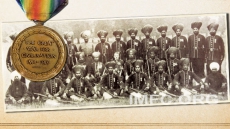“Tea is as universal in its appeal as it is a private expression of individualism. It is like perfume, very personal, and everybody can find what suits his/her tastes.”
What is the first thing that comes to your mind when you hear the word ‘tea’? Does it remind you of its soothing taste or of the special tea your mom so lovingly made, or does it revive fond memories of a meeting with friends or a romantic date? Knowingly or unknowingly, for many this warm beverage has become a constant companion of everyday life. “Tea is the second most consumed drink in the world, next to water. There are even some cultures which consume tea when they are thirsty, instead of water,” reveals Maranda Barnes, co-founder and director of business development and corporate communications at
TWG Tea, a globally-known tea brand that started in 2008.
The origin of tea dates back thousands of years. Tea plants are native to East Asia, and probably originated in the borderlands of north Burma and southwest China. “For millennia, tea has shaped landscapes and geography, cultures and traditions, destinies and desire. Tea is native to Asia and is the reflection of every tea producing country’s culture and civilization. Everyone in Asia is born with a proverbial cup of tea,” says Barnes, further sharing an interesting fact on the drink. “The surprising truth behind tea that is often forgotten is all the different types (black, green, blue (oolong), yellow, white) originate from one sole plant species called Camellia sinensis.”
There is no denying that tea plays an integral role in the South Asian community, and drinking it daily has become a common habit for many. In fact, India is the second largest producer of tea in the world after China and is considered to be the world’s largest tea-drinking nation. Though there is no clear documentation on tea’s origin in India, according to Barnes “after wild tea plants were discovered in India in the early 19th century, tea has been infused into the culture ever since.” Pointing out the highest tea-producing regions of India, she says that the drink has been woven into many aspects of South Asian lifestyle for centuries. “The Darjeeling region, many associate as the champagne of teas, is highly sought after for their exceptional quality and unique flavours and is only one of many highly celebrated tea producing regions. Also, Assam, Nilgiri, Sikkim and Himachal Pradesh are all vital regions shaping the rich tea culture in South Asia. It has grown to be a part of their heritage.”

A quick look at tea consumption among various cultures and countries is enough to confirm that it is imported and exported on a large scale around the world. The tea industry contributes greatly to the economic growth of countries exporting tea, especially China and India. “15,000 cups of tea are drunk every second all over the world. In 2015, tea sales in Canada amounted to $1.3 billion CDN and consumption is expected to grow an additional 40 percent by 2020,” states Barnes, adding, “Every type of tea that is present in the market has a positive influence on the tea industry as they support tea growers in their quest to gain knowledge and produce exceptional teas.”
The history, facts and statistics all boil down to the fact that tea is a universal drink – one that does not have any boundaries and can be enjoyed in the way that best suits your taste. “Tea is as universal in its appeal as it is a private expression of individualism. It is like perfume, very personal, and everybody can find what suits his/her tastes. TWG Tea believes there is a tea for everyone and every occasion,” shares Barnes.
Tea has the unspoken power of bridging the gap between communities and statuses. So the next time you have a cup of tea, remember that something as simple as tea leaves has reshaped history, unified people, and connected the world. It is not just a drink anymore, it represents universality.
Did you know?
There are over 3,000 varieties of tea from around the world, distinguished by the processing methods they undergo.
White tea has the highest concentration of antioxidants.
Yellow tea is the rarest and most expensive tea in the world, dating back to the 16th century. TWG Tea’s most exquisite Yellow Gold Tea buds are lavished in 24-karat gold, which once infused, yields a delicately metallic and floral aftertaste.
Red teas or rooibos actually does not belong to the Camellia sinensis family. It comes from a bush known as Aspalathus linearis and it is harvested in February or March at an altitude of 1,500 feet in the Cederberg region of South Africa.
Try out these Beau‘tea’ treatments
For centuries, teas have been used as a rare and precious ingredient in beauty treatments.
Facial toner
Green tea has anti-inflammatory and antioxidant properties when applied to the skin. To create a refreshing and detoxifying facial toner, simply infuse a very strong cup of green tea and add a spoonful of fresh lemon juice. Pour into a spray bottle, shake before using and apply to the skin as a toner with a cotton swab.
For blond highlights
To brighten blond hair and enhance golden highlights, prepare a generous infusion of chamomile with a spoonful of fresh lemon juice. Mix well and apply to clean, dry hair. Expose hair to the sun’s rays for a few hours for natural sun-kissed highlights.
To treat an oily scalp
For a vitamin B-rich, tea-infused hair and scalp cleanser, dilute a small amount of clay in an infusion of hot green tea. Cool the mixture and then apply it to your roots
for 15 minutes before rinsing thoroughly.
For chapped lips
To heal sore and chapped lips, apply a cool, pre-infused teabag to the lips to promote cell renewal and to protect lips from the drying effects of cold or wind. Follow with a coat of natural lip balm for additional protection.
To soothe skin after waxing
To soothe skin irritations after hair removal, apply a pre-infused teabag of black tea on the affected areas for a few minutes and then rinse.
To relieve tired eyes
To overcome dark circles and puffy eyes, place two cool, pre-infused teabags on your eyes for a few minutes. The natural tannins and vitamins in the tea will decongest, stimulate, smooth and revitalize the contours of the eye while alleviating dark circles, leaving your eyes fresh and rejuvenated.
For a safe tanned hue
Replace your expensive tinted creams with this homemade tanning lotion. Brew a very strong cup of red or black tea and apply the infusion to your skin with a cotton swab. Allow the lotion to dry before rinsing. Use this recipe to maintain a healthy, tanned appearance all year long.
To alleviate sunburn
After prolonged exposure to sun, the skin is considerably weakened and dehydrated. To remedy this and alleviate the discomfort of sunburn, soak in a cool bath mixed with six to eight litres of a strong tea infusion. The tea will contribute to the regeneration of skin cells, as it is rich in vitamins A andB, and zinc.
To protect against odours
To refresh a pair of shoes and eliminate unpleasant odours, place a gauze sachet filled with green tea in your shoes for a few days. The chlorophyll in the tea leaves will eliminate any odours. You may also wish to take advantage of the deodorizing virtues of green tea by using a similar tea infusion during a footbath.
To strengthen teeth and nails
As a mouthwash, tea contributes to a healthy mouth, preventing the onset of dental decay and fortifying the enamel, while the tannins in tea sweeten your breath. For a pleasantly fresh-tasting tea mouthwash, choose a mint green tea. To strengthen nails, soak in a warm tea infusion for several minutes.
- Inputs by TWG Tea









